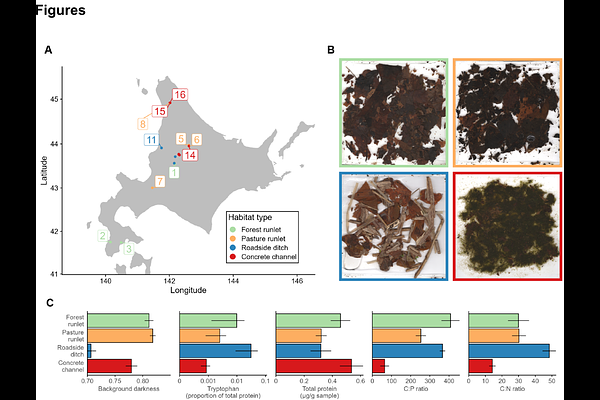Nutritional effects on the expression of cryptic pigmentation in freshwater isopods

Nutritional effects on the expression of cryptic pigmentation in freshwater isopods
Lurig, M. D.; Matthews, B.; Schubert, C. D.; Kishida, O.
AbstractCryptic pigmentation is a key phenotypic adaptation that helps many invertebrates evade visual predators. However, little is known about whether and how the expression of pigmentation phenotypes that match the habitat background is influenced by the availability of nutritional resources. Here we investigated whether variation in both the background and the nutritive composition of benthic substrates affect the expressed pigmentation of freshwater isopods (Asellus hilgendorfii). We collected isopods and their predominant substrate from 17 locations across Hokkaido, northern Japan, and quantified substrate background and nutritional composition (total protein, 18 amino acids, and C:N and C:P ratios). We found that variation in isopod pigmentation was better explained by the substrate\'s nutritive composition than by its background darkness. Specifically, isopods were more pigmented when substrates had intermediate C:P ratios, lower C:N ratios, and a higher proportion of tryptophan - an essential amino acid involved in the isopods\' pigmentation pathway. These results are consistent with previous experiments showing that isopods reared under diets with higher protein concentrations developed more pigmentation, advancing our understanding about the environmental sources of phenotypic variation in natural populations. By demonstrating that nutritional constraints may shape the expression of key phenotypic adaptations in natural populations, our study opens new directions for exploring how organisms navigate adaptive landscapes; particularly in those organisms that rely on pigmentation for signaling and camouflage. Finally, we demonstrate how macronutrients, amino acids, and elemental ratios can serve as biotracers in ecological studies of adaptation, offering new opportunities to examine how stoichiometric traits influence phenotypic plasticity and adaptive capacity, especially in detritivorous taxa.